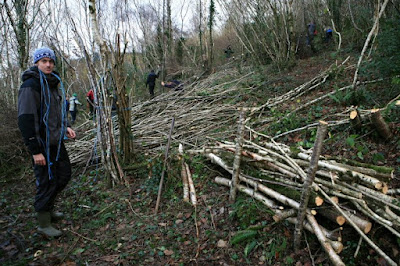
Back in November we travelled to a woodland owned by Saul Mossbacher where we learned first-hand about coppicing by harvesting a crop of hazel.
Coppicing is the oldest form of woodland management. It essentially involves cutting the stems of the tree down to the stump. They then re-grow producing multiple stems, or poles.

Typically a coppiced woodland is harvested in sections or on a rotation. In this way, a crop is available each year somewhere in the woodland. Coppicing has the effect of providing a rich variety of habitats, as the woodland always has a range of different-aged coppice growing in it, which is beneficial for biodiversity. The cycle length (7-20 years) depends upon the species cut, the local custom, and the use to which the product is put. Not all tree species can be coppiced, only those that tend to sucker when cut.

In the case of hazel the poles are harvested approximately every 7 years and converted into a wide range of products including woven hazel fencing, rustic furniture, and poles for building things such as yurt frames.



Coppicing has the effect of maintaining trees at a juvenile stage, and a regularly coppiced tree will never die of old age. The age of a stool may be estimated from its diameter, and some are so large (perhaps as much as 9 m or 30 ft across) that they are thought to have been continuously coppiced for many centuries. There is a growing movement in Ireland and Brittain to return abandoned coppices to rotation. Word travels among the 'interested' of a disused coppice that has been rediscovered, eyes widen and palms are rubbed together in hopes that a way can be found to remind folks of the forgotten value of a sustainably-managed woodland.




During harvest we sorted the poles according to size and straightness and bundled them for easier transport and sale.


No comments:
Post a Comment